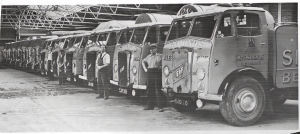In the ever-evolving landscape of modern business, the efficient and effective movement of goods and services is an indispensable cornerstone of success. This intricate web of logistics, often facilitated by fleets of vehicles and specialized machinery, forms the circulatory system that sustains countless industries across the globe. From the early days of rudimentary record-keeping to the technologically advanced and safety-focused juggernaut of today, Fleet Management has undertaken a remarkable journey. It is a journey that not only echoes the footsteps of progress but also resonates with the heartbeat of safety.
This series of blog articles embarks on an expedition through time, tracing the evolution of fleet management. Our odyssey encompasses the genesis of this critical discipline, its gradual metamorphosis, and the integration of cutting-edge safety measures and technologies that are pivotal in contemporary fleet operations. As we traverse the corridors of history, we will spotlight the key milestones, technological advancements, and paradigm shifts that have marked this journey. Our exploration will culminate in an in-depth examination of the current state of fleet management, where safety reigns supreme, and the services we offer at Xevolvex.com play a pivotal role in ensuring not only efficiency but also the utmost safety.
Chapter 1: The Genesis of Fleet Management

Our voyage begins with a journey back in time to an era when the concept of fleet management was in its infancy. Picture a world where businesses, albeit on a smaller scale, were becoming increasingly reliant on the transportation of goods and materials. It was a time when the notion of systematically managing a fleet of vehicles and the machinery that supplied them, began to take shape.
In these nascent years, the term “fleet” conjured images of a modest collection of vehicles, often comprised of trucks, cars, tractors, cranes or horse-drawn wagons. These early fleets served various industries, from manufacturing, ports and agriculture to construction and delivery services.

The Birth of Necessity
The birth of fleet management can be attributed to the growing recognition that ad-hoc approaches to managing these small fleets were no longer sufficient. As businesses expanded, so did their reliance on these vehicles. What was once a straightforward affair of ensuring that vehicles remained operational had evolved into a complex undertaking.
Fleet management emerged as a necessity born out of operational challenges. With the increased use of vehicles, the need for systematic oversight became evident. It was no longer feasible to rely solely on the goodwill of drivers and ad-hoc maintenance practices to keep the wheels of commerce turning.
Early Record-Keeping Practices
The genesis of fleet management was marked by manual record-keeping practices. In an age devoid of digital technology, the management of vehicle fleets relied heavily on paper-based systems. Each vehicle was equipped with a logbook, a tangible repository of invaluable information. Drivers meticulously recorded essential details about their journeys, maintenance activities, fuel consumption, and more within these logbooks.
These logbooks served as the lifeblood of fleet management during this era, representing the primary means of tracking the movements and maintenance history of each vehicle. They contained not only historical data but also the potential for insights into the performance and efficiency of the fleet. However, they were limited in their ability to provide real-time information or facilitate comprehensive data analysis.
Maintenance and Breakdowns: The Cost of Reactive Practices
Maintenance practices during this period leaned more toward reactivity rather than prevention. Vehicles received attention when they exhibited visible signs of wear and tear or when they succumbed to unexpected breakdowns. This reactive approach resulted in frequent and costly interruptions to fleet operations, contributing to operational inefficiencies and increased downtime.
For instance, if a delivery truck experienced engine trouble or suffered a flat tire, it often meant an unplanned and costly halt in operations until a repair or replacement could be arranged. Such breakdowns not only incurred immediate repair costs but also resulted in delayed deliveries, customer dissatisfaction, and potentially lost business opportunities.
The Simplicity of Early Vehicles
It’s important to recognize that the vehicles and machinery of this era were relatively simple compared to today’s technologically advanced counterparts. They lacked the sophisticated electronic systems, onboard computers, and sensors that define modern vehicles. As such, maintenance and repair tasks were more straightforward and often required basic mechanical skills that drivers or in-house mechanics could perform.
However, the simplicity of early vehicles did not exempt them from the need for meticulous maintenance and record-keeping. Vehicle reliability remained paramount, especially when businesses depended on these fleets for the transportation of goods and services.
The Role of Fleet Managers: Jacks of All Trades
The concept of a dedicated fleet manager, as we understand it today, had yet to take shape during this embryonic stage of fleet management. Instead, the responsibility for overseeing fleet operations often rested squarely on the shoulders of business owners or managers who assumed multiple roles. These individuals juggled myriad responsibilities, including ensuring the availability of vehicles, managing maintenance schedules, and monitoring driver behavior.
Fleet management, in its earliest form, was more about addressing immediate issues and ensuring that vehicles remained operational rather than proactively optimizing operations or placing a significant emphasis on safety. Nonetheless, the seeds of organized fleet management had been sown, setting the stage for the transformative journey that awaited in the decades to come.
The Evolution of Fleet Management: A Glimpse into the Future
As we venture further into the annals of fleet management history, subsequent chapters will unveil the transformative impact of technology on the industry. The introduction of computers and early software solutions marked a significant shift, setting the stage for more efficient and data-driven fleet management practices.
Our journey through time will explore how technology revolutionized fleet management, giving rise to real-time data tracking, route optimization, and the ability to make informed decisions based on comprehensive data analysis. Safety will emerge as a paramount concern, with the integration of safety protocols, driver training, and proactive measures to mitigate accidents and ensure the well-being of drivers and the general public.
In the chapters ahead, we will delve deeper into these transformative periods, highlighting specific technological advancements and safety measures that shaped the modern landscape of fleet management. The journey will ultimately lead us to the present day, where cutting-edge technologies and comprehensive safety solutions, such as fatigue management technologies, play pivotal roles in ensuring not only the efficiency but also the utmost safety of fleets and their personnel.
Join us on this expedition through time as we unveil the story of fleet management’s evolution, from its humble beginnings to the zenith of safety-focused operations. This comprehensive series promises to be an interesting exploration of an essential industry’s transformation. Stay tuned for an enlightening journey through the evolution of Fleet management and Safety.
These will be the next chapters on this blog series:
Chapter 2: Technological Revolution
Chapter 3: Embracing Safety as a Priority
Chapter 4: The Birth of Telematics
Chapter 5: From Distraction to Fatigue Management
Chapter 6: The Contemporary Landscape and Artificial Intelligence

